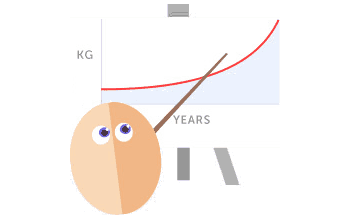Hmm, I was sure we had debunked this study but I can't remember it so perhaps it was in one of the facebook groups before we got the forum set up. There are so many holes in it, it's hard to know where to start.
Their greater muscle mass also protects men from some of the downsides of the diet. Dr Collins explains: “The average adult turns over 300grams of protein a day.
Eighty per cent of that is recycled, broken down and reused; a bit like Lego bricks, but after a certain period of time these proteins become worn out and are lost to the body.
“What we cannot salvage, we need to replace and once you start skipping meals you will compromise your intake.
“Protein is non-negotiable, and unlike other micronutrients you need it every day, but men have a higher reserve of muscle they can call on for protein during fasting days.”
The protein requirements are only around 46g/day for a woman, 56g/day for a man. On my fast days I am usually having around 40-50g protein anyway so no problem there. Even if you did not eat any high protein foods such as meat/dairy etc, one day without protein would hardly cause your body to fall apart. And in any case, most people in the developed world are overeating protein and this is a factor behind many cancers. Reducing protein to under 60g per day is recommended to lower IGF1 and so cancer risk. When the body is not getting new protein it uses the old worn out cells for spare parts (autophagy) which destroys cells that might turn into cancer cells. So, all that concern about protein intake is bunkum.
The danger was identified in a 2005 study published in Obesity Research which tracked eight men and eight women as they tried intermittent fasting for three weeks. All were a healthy weight or carrying only a few extra pounds, with BMIs between 20 and 30.
At the end of the trial there was no insulin improvements in the women and their glucose response got worse, while the men had no glucose changes and their insulin response improved.
Several problems here. First they were looking at normal weight people whereas most of the people on the forum are looking to lose weight. As insulin resistance is highly associated with overweight and reducing weight improves glucose tolerance, this is a good thing. Fasting also improves glucose tolerance in people with insulin resistance because during fasting insulin levels are lowered.
However, what about when we reach our target weight I hear you ask? Well, another problem with the study mentioned is that if you look at what happens in the body when given glucose following a fast you do get higher blood glucose levels and lower insulin levels than you would like but that is because the high levels of circulating fatty acids that were being used to supply energy during the fast inhibit the action of insulin (because you don't want to store any incoming glucose as fat when you first start to eat after a fast, you need it to be turned into glycogen). However, after a short time, everything goes back to normal. If the researchers had waited for another day of normal eating they would have got different results. Also, the subjects in this study had a complete 36 hour fast every other day which is very different from a very low calorie day twice a week which is what we are doing in 5:2. I really don't think this is an issue because anyone with normal body weight is not going to be doing alternate day fasting unless they want to disappear completely!
In part, this may be due to differences in the way we store fat. Women are most likely to be pear-shaped and pile extra pounds on to their hips while men become apple-shaped and gain weight around their middle, which is much more dangerous and increases the odds of developing diabetes and heart disease.
Dr Collins says: “You would expect men to benefit more because the natural distribution of their body fat predisposes them to metabolic syndrome [a precursor to diabetes]. Losing weight around the middle will increase insulin sensitivity, and reduce their risk.”
This dangerous apple-shape becomes more common in women after menopause, which suggests there may be some benefits to the 5:2 regime for those over 50. However, for younger women there are serious concerns about fasting and fertility.
I think you only have to look around to see that these days most women are apple shaped whatever their age. Even women who are pear shaped have excess fat around the middle too. (I don't know why this has changed over the years. I have my suspicions about certain types of fats appearing in ready made foods but no proof). But the evidence all around us shows that few women doing 5:2 will be 'at risk' from 5:2. Rather most of us are at risk if we don't take some kind of action over our weight.
Studies at the American National Institute on Ageing found that when rats are put on a restricted diet the females stop ovulating and their ovaries shrink.
Being overweight reduces fertility too. You have to go very low in weight before it affects fertility.
Eating disorders are rooted in psychological problems, but she says fasting encourages “disordered eating” and that could tip at-risk dieters into a full-blown eating disorder. “Fasting creates a feeling of euphoria because blood sugar is running quite moderately and that can be addictive. It is very important that you don’t do more than two days a week,” she says.
What on earth does "blood sugar is running quite moderately" actually mean? Anyway, it seems to me that the major issue in today's world is not anorexia but obesity. It is highly unlikely that someone who has struggled with overeating for years is going to tip into anorexic behaviour.
The warning is borne out by research at Columbia University which found changes in female brain chemistry are directly related to food intake; the greater the hunger, the bigger the impact.
As we all know by now, after fasting our hunger is reduced not increased.
In female rats, even a modest cut in calories triggers a sharp increase in corticosterone levels and encourages the body to lay down fat stores, according to studies at the National Institute of Ageing.
Fasting results in low insulin levels which actually prevents fat from being laid down but rather fat is mobilized. Increases in corticosterone levels do not occur with fasting until a couple of days into the fast. Again we are only fasting for 1 day at at time. The sentence quoted would be more suitable to be used to explain why normal calorie restriction dieting results in fat gain.
Dr Collins says, “We have to get away from this idea that the 5:2 diet is a panacea, an optimum diet. It isn’t.
No, I don't think we are claiming it is an optimum diet. What we
are claiming is that, in a situation where we are faced with massive food availability particularly of foods that our bodies have not evolved to deal with and which are highly desirable because of their sugar and fat content, this diet allows us to compensate for some of the undesirable consequences of over nutrition while enabling us to continue to eat the foods we like. Of course it won't suit everyone, but no diet will do.
Oddly, the studies that do give some cause for concern about fasting and lowering IGF1 are not mentioned! These relate to low IGF1 and development of frailty and to fasting and heart muscle problems. Elderly frail people often have low IGF1 but whether that is because these folks have reduced their calorie intake or whether the low IGF1 develops in age anyway is not clear. Presumably when any of us reach a great age and are getting too thin we would stop fasting. The relationship between fasting and heart muscle problems are to do with high circulating fatty acids (that you get when burning fat for fuel) and are seen with chronic ADF in rats. As we are not alternate day fasting or even for those who are we don't see it as a long-term lifestyle, I think this is
probably not a concern. It is worth remembering that any extreme intervention is likely to have detrimental effects so lets just keep to 5:2 or 6:1 in the long term.
I'm sorry I haven't posted links to the research supporting some of my statements but I can hunt them down in time if you would like to see them.







